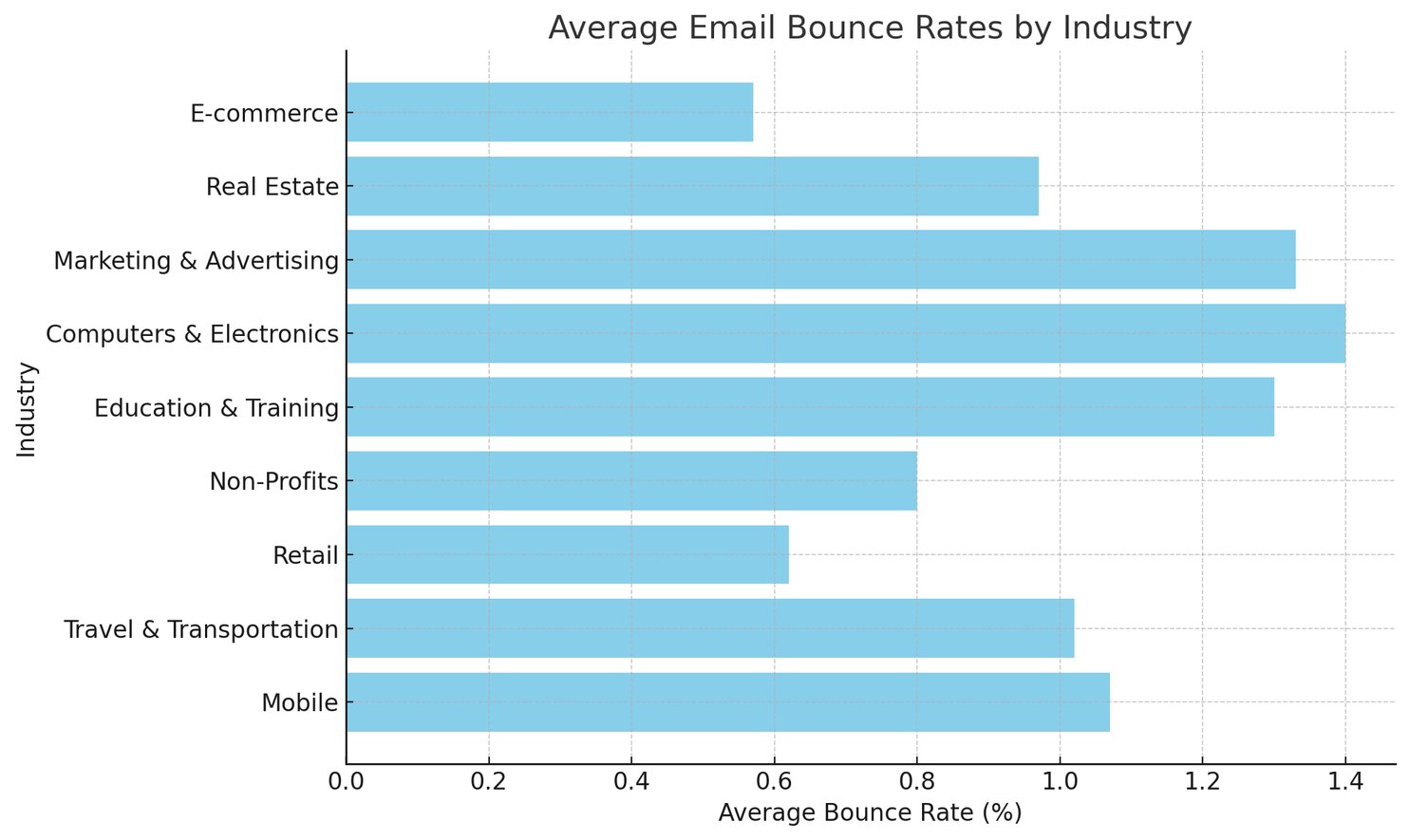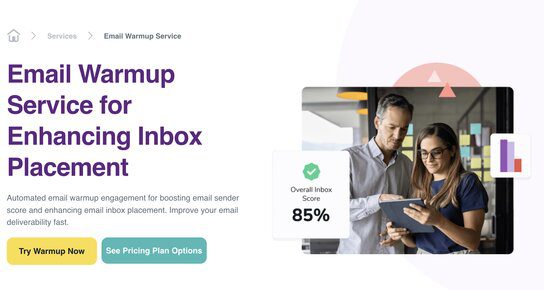
The Email Bounce Rate Benchmark — How Do You Compare?
How do your bounces compare to the average email bounce rate benchmark? Learn what’s considered a healthy bounce rate in your industry and get some tips for reducing bounces and improving email deliverability.
Email bounce rates differ across industries, and knowing the typical bounce rate in your sector can help you assess your email performance.
Although an “acceptable” bounce rate varies based on your industry, you should still always consider zero the ultimate ideal. Some industries tend to see higher bounce rates than others, but regardless of industry, the tactics for keeping a low bounce rate are universal.
Average email bounce rate benchmark across industries: What’s normal?
To understand how your business compares, let’s look at some of the data.
Mailchimp, one of the most popular email service providers, analyzed billions of emails and their average bounce rate. Then it categorized this data according to industry, so you can get a clear picture of your email marketing performance.
Here are some of the email bounce rate benchmarks you can compare your metrics to:
- Emails for e-commerce businesses typically have a lower average bounce rate, averaging 0.57%. Some believe this is because professionals in those industries have more knowledge about email validation and are more likely to follow data-driven practices.
- Real estate companies, on the other hand, can experience bounce rates averaging 0.97%. Marketing and advertising businesses generally experience a bit more bounces, averaging 1.33%.
- Marketing and advertising businesses generally experience a bit more bounces, averaging 1.33%.
- Interestingly, computers and electronics have a somewhat high bounce rate at 1.4%. Those in that industry should remain diligent.
- Education and training are also one of the higher categories at 1.3%.
- Non-profits fare better at 0.8%.
- Retail emails tend to receive lower bounce rates at 0.62%.
- Travel and transportation has an average bounce rate of 1.02%.
- Emails in the mobile space are in that same ballpark at 1.07%.

Understanding these averages can guide you in setting realistic goals for your email campaigns. If your bounce rates are higher, it’s time to reassess the health of your email list and remove any invalid and fake contacts.

Also, you can get a more personalized analysis with ZeroBounce’s free email bounce rate calculator. It provides industry-specific benchmarks and custom calculations to help you evaluate and improve your bounce rate.
Key factors influencing email bounce rates
Several factors can affect your email bounce rate, and they’re often interconnected. Being aware of what can hurt your performance is the first step to improving your email deliverability.
Here are some of the primary influences.
Email list hygiene
This is the most critical factor in keeping your bounce rate low. If your list includes outdated or incorrect email addresses, this leads to hard bounces—when emails are permanently undeliverable. Regularly cleaning your list by removing inactive or inaccurate addresses will reduce your bounce rate.
Sender reputation
Internet Service Providers (ISPs) are always trying to combat spammers. They determine who is legitimate and who is a spammer based on sender reputation. Even if you don’t send spam, you could get grouped with spammers if your sender reputation starts to dip.
High bounce rates are one of the top ways you can damage your sender reputation, which will inevitably make it harder for your emails to reach inboxes. Maintaining a good reputation requires consistent email list hygiene and frequent monitoring of all metrics.
A decline in metrics should be cause for pausing and getting to the root issue. Don’t neglect any drastic changes or you could end up with an issue.
Email content and frequency
If you go overboard by constantly flooding people with emails, you’re going to get more bounces. One reason is that overwhelming people may cause them to stop opening your emails or even hit the junk button.
Another culprit is that certain types of content can cause “soft bounces,” where the recipient’s inbox rejects the email temporarily. Testing content and getting the frequency right can help reduce bounces.
Related: Learn the difference between soft bounces and hard bounces
Domain and IP reputation
Sending from a domain or IP with a poor track record—possibly due to previous spam or high bounce rates—can lead to more bounces. Building a positive reputation with ISPs helps improve email deliverability.
Understanding these factors can give you a better grasp on managing bounce rates and creating strategies to keep them low.

How to benchmark your email bounce rate
Benchmarking your bounce rate against industry standards can help you understand how well your email campaigns are performing.
As a general rule, an overall bounce rate below 2% is considered healthy, but the closer you can get, the better your sender reputation will be.
Here’s a breakdown of how to interpret different bounce rate ranges:
- Less than 1%: This is the ideal bounce rate, indicating strong email list health with a good sender reputation.
- 1% – 2%: This is within the average range for most industries, but there’s room for improvement.
- Over 2%: A bounce rate above 2% is considered high. In this case, you need to examine your list hygiene and practices – and investigate if you are on any blacklists.
For accurate insights, use ZeroBounce’s email bounce rate calculator to get real-time comparisons with others in your industry.
Tips to reduce bounce rates and improve email deliverability
Reducing email bounce rates isn’t hard – so long as you follow a few simple steps. Also, it’s well worth the effort since your email deliverability is directly related to how many of your emails bounce.
Here’s what you can do to keep bounces at bay, improve sender reputation, and get your email campaigns in the inbox.
Verify your email signups
Use an email verification tool API on all of your contact collection forms to weed out incorrect or potentially harmful email addresses. An email verifier ensures that you’re only sending emails to valid addresses, which is your first safeguard to reduce bounce rates.
Warm up your domain
For new domains or those with limited sending history, gradually increase email volume instead of sending out mass emails immediately. This helps to build trust with ISPs and can improve email deliverability over time. You can even use an email warmup tool to make things easier and have more control over how you manage this process.

Clean your list regularly
At least 25% of your database decays every year. Regular list cleaning — at least every quarter — is essential to avoid sending emails to unengaged or inactive users. Consistent maintenance keeps your list healthy and reduces the chance of high bounce rates.
Optimize sending frequency
Too many emails can overwhelm recipients and lead to bounces or spam complaints. In turn, spam complaints can damage your sender reputation, which leads to bounces as ISPs block or filter your emails. To avoid that, assess your sending frequency to ensure it aligns with your audience’s preferences.
Related: Learn how disposable emails can affect your bounce rate
Refine your email content
Avoid using spam-triggering phrases or overly complex designs that might be blocked by spam filters. Instead, focus on clear and concise messaging that resonates with recipients and meets ISP standards.
Use double opt-in
Permission marketing is the name of the game. Always go that extra step to ensure that everyone on your list has agreed to be there. Double opt-in generates an automated email that requires anyone interested in signing up to click a unique link. If they don’t click the link, they won’t get your emails. It’s a good way to avoid invalid and fake signups and keep your list in good shape.
So, how do you compare to the email bounce rate benchmark?
Following these practices above helps you abide by bounce rate industry standards and keep your emails landing where they should—right in your customers’ inboxes.
Just remember: it’s not “just a bounce.” It’s an opportunity to continuously improve. By not tolerating an above average bounce rate, your list will be optimal. And with a healthy email list, you’re on the right path to improving email deliverability and connecting with your prospects.
Not sure how to start checking the health of your list? Sign up for a ZeroBounce account and get 1,200 yearly free email verifications. If you need help, our team is available 24/7 – yes, weekends and holidays included.
Table of Contents
- Average email bounce rate benchmark across industries: What’s normal?
- Key factors influencing email bounce rates
- Email list hygiene
- Sender reputation
- Email content and frequency
- Domain and IP reputation
- How to benchmark your email bounce rate
- Tips to reduce bounce rates and improve email deliverability
- Verify your email signups
- Warm up your domain
- Clean your list regularly
- Optimize sending frequency
- Refine your email content
- Use double opt-in
- So, how do you compare to the email bounce rate benchmark?






